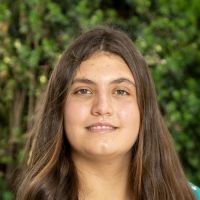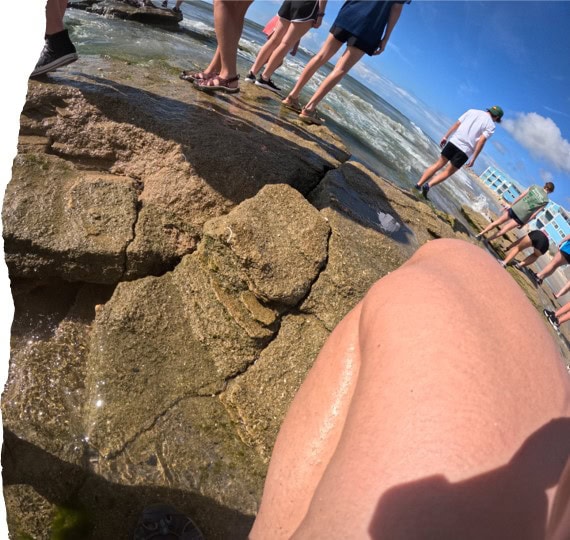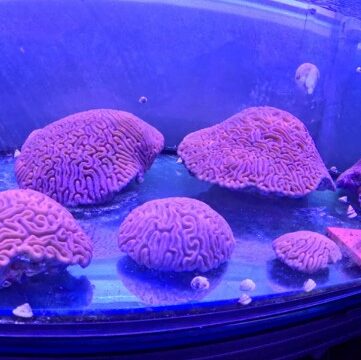November 2024
Sophia Dove, a student at National Cathedral School, was the first recipient of an All Hallows Guild environmental scholarship of $1000 to go toward appreciation and understanding of the outdoor world. Sophia used the money to cover expenses for a week-long summer program with the University of North Carolina Wilmington and took detailed notes. Please enjoy her report reprinted below.

On Sunday, July 7, I checked in at Terrapin Hall, where I stayed for the week of my program. After check-in, I set up my room, went to dinner, and then went to the beach in the evening. The dorms were suite-style, so I had a roommate and two other dorm-mates in the suite.
On Day 1, we started in one of the UNCW labs, where we reviewed our itinerary and did introductions. We then went to a yacht club to scrape the docks for “fouling community.” The fouling community consists of organisms that are considered pests for boat owners and dock workers, such as barnacles, sea squirts, and sponges, but also includes crabs, sea stars, and corals. We scraped the sides of the docks with small nets to collect as many organisms as we could and then placed them in water-filled buckets for further investigation. When we returned to the lab we tested sponge samples we had taken from the docks along with sponge samples from the Caribbean to test to see if any of them contained compounds which could kill a strain of E-Coli. We crushed up each sponge sample in alcohol and put it on an agar plate which contained the E-Coli, along with one other sponge sample and a positive and negative control. In doing this, we learned about the first step in the process of finding a compound in oceanic life to turning it into a pharmaceutical product which can be used by patients. We also looked at water samples taken from the docks to test them for high concentrations of nitrogen and phosphorus. High concentrations of either of these elements can lead to algal blooms which leech nutrients out of the water, creating what is called a “dead zone.”

On Day 2, we set out for a residential beach close to a historic site. We discussed the impacts of the barrier walls erected to protect the site on the beach ecosystem, and looked at the coquina rocks in the area, named for the tiny shell fragments which fused to create the rocks. In the photo, if you look closely, you can see the makeup of the rocks, which is variable because of the shells. We also discussed beach renourishment. On this beach, there are many homes, but as we saw, sea level rise has eroded the beach under the houses- we saw a lot of sandbags supporting stilts which were being used to keep the homes standing. One of the actions the state has been taking to preserve this real estate is beach renourishment, a process where sand is taken from the seabed and put on beaches to refresh them. Later, we hiked through the marsh and learned about its importance to the marine ecosystem. Many of the fish and crustaceans in the ocean are born in marshes, but marshes are disappearing. Marshes would usually move backwards away from sea level rise, but because of roads, marshes are trapped between the roads and the rising oceans, so they are going under the waves. We got to investigate some of the sea life living there through seining, where two people hold a net which is strapped between two poles and shuffle it across the bottom to catch sea life. A third person, the “taco-person,” then folds the net from the bottom to keep the creatures in the net until the net arrives on land with the catch, in which case, either the creatures are put in water-filled buckets or released back into the water. We caught a variety of creatures, including blue crabs, snails, shrimp, and multiple types of fish. After this, we visited Wrightsville Beach, where we looked at sea level rise through measuring the changes in shoreline elevation. We had a device built out of two rods with rulers on them, and a string in between, and we crab-walked it down the beach. The changes in sea level rise were measured through the movement of the string. We then returned to the science building to speak with a professor who was working on measuring levels of heavy metal in the intercoastal waterway through measuring the amounts of heavy metals found in oyster tissue.
On the third day, my group took a kayaking trip through one of the estuaries which branches off the Intercoastal Waterway. We looked at the effects of sea level rise on the ecosystem. It is most apparent in the trees. This area used to be a freshwater ecosystem, but because of sea level rise, the area has been flooded with seawater. All the salt killed the trees, but the wood is still standing, creating a ghost forest. Birds still like to nest in the trees though – I saw multiple ospreys and osprey nests while kayaking. Afterwards, we tested plastic that we had been collecting throughout the trip for which of the seven types of plastic they were.

On Day 4 of the camp, our group took a trip on the research vessel the R/V Cape Fear. We learned to use many different tools that researchers use to measure different factors. Pictured here is the Ponar grab, a tool which is dropped to the ocean floor, and upon contact, a spring releases, capturing sediments. Scientists use this data to determine where could be the best place to get sands for beach renourishment. We also took plankton samples, and measured water turbidity – also known as clarity – through two different tools. One device measured it digitally, and the other was a measurement-marked rope with a black-and-white disk at the bottom through which we measured the distance down after we could not see the disk anymore. After everyone took a turn using the different tools, we went out farther off the coast and did a trawl. We caught many creatures, such as a butterfly ray, a flounder, and multiple squid, shrimp, and other fish. There were also some sharks circling the boat, because they have learned that when there is a trawl, fish are thrown back into the water, and they will usually get a meal. When we returned to the lab, we looked at our plankton samples under the microscope.

On Day 5, we started the day learning about corals and the issues facing them at the Center for Marine Science’s Coral Lab. Coral bleaching events, which happen when rising sea temperatures cause corals to expel the algae which feeds them, are killing corals all over the world. Scientists have therefore been trying to study corals and grow new ones to replace the ones which have died as a result of the bleaching events. To grow corals, scientists black out all the rooms and only use red light, as corals use the light from day to night changes to figure out when to reproduce. The scientists control all the other light in the room so they can decide when to have the corals reproduce. After our trip to the Coral Lab, we returned for lunch, and then worked on the end-of-program presentations which we would be presenting to our parents later that day.
Although my original intent was simply to make NCS more coral-friendly, the program I attended had a broader perspective. We certainly touched on issues impacting corals, but I learned how various interconnected issues have far-reaching impacts on coastal ecosystems. Three such related issues are: 1) the creation of dead zones via fertilizer runoff, 2) harm to a plurality of ecosystems due to warming oceans, and 3) beach erosion. For example, through fertilizer runoff, excess phosphorus and nitrogen enter the oceans and create algal blooms. These algal blooms feed off these elements, upending the ecosystem from its necessary and natural nutrient concentrations. Ultimately, these blooms deprive the ecosystem of its nitrogen and phosphorus, creating dead zones, where little can flourish and life is not well-sustained. Secondly, global warming and increasing ocean temperatures are detrimental to the coral reef ecosystems. More specifically, the increasing water temperatures cause shallow-water corals to expel the colorful algae that they use for food. The loss of this nutrient source eventually kills the coral. Thirdly, warming oceans also impact sea level, causing it to rise, which is harming coastal river freshwater ecosystems by introducing an excess of salt. Rising sea levels also erode public beaches and the land around coastal homes. This erosion impacts not only those that live there, but also the local governments as well which must garner the manpower and funding to renourish the beaches. Further research projects could include investigation into the decrease of fertilizer runoff, to keep it out of local waterways; exploration into sustainable, cost-effective, and lasting erosion solutions; or inquiry into global warming solutions.


